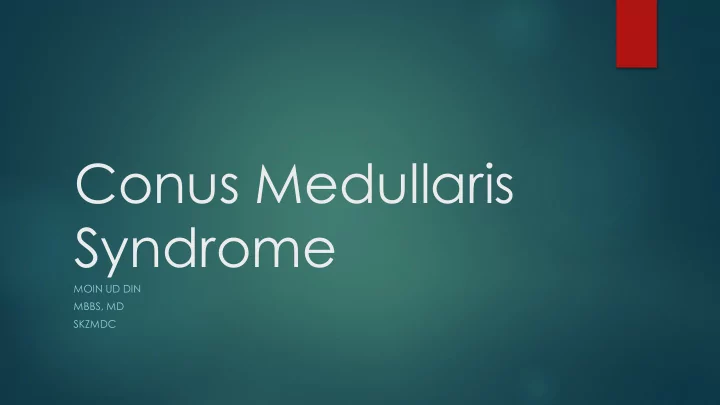

Conus Medullaris Syndrome MOIN UD DIN MBBS, MD SKZMDC
Acute back pain radiating to 1. bilateral lower limbs Urinary retention 2. Stool retention 3. Presentation Perianal Numbness 4. Numbness and tingling sensation 5. in bilateral lower limbs Sexual Dysfunction (Impotence in 6. men)
Both upper and Babinski reflex lower motor and neuron signs Bulbocavernosus present reflex present Signs Hyperreflexia Achilles reflex is and flaccidity affected; are concurrently Patellar reflex is presently preserved
Pathophysiology and Risk factors Conus medullaris is the end part of spinal cord. In most adults it is as L-2 levels with some variations from T-12 to L-2 levels. Compression of spinal cord at this level is conus medullaris syndrome. Most common cause is trauma. Other causes include Infections (Tb, HSV, Meningitis, CMV) and malignancy(Primary and metastasis).
Thorough history is important to look for recent Diagnosis trauma or chiropractic manipulation, history of malignancy, intravenous drug use and constitutional symptoms like fever/chills. Detailed physical examination is important to differentiate from other spinal compression causes. Look for presence of UMN and LMN signs, Palpable bladder showing urinary retention, Absent or decreased rectal tone/ Bulbocavernosus reflex. Gold standard for diagnosis is Urgent MRI Ideally within 1 hour of presentation for favorable prognosis.
Cauda Equina Syndrome Spinal Cord Infarct Differential Multiple Sclerosis Infections Diagnosis HIV-related Myelopathy i. Transverse Myelitis ii.
Management Surgical Decompression (Laminectomy) is the main treatment option If cause is cancer, radiation therapy ( Brachytherapy ) maybe required Physical therapy is essential to regain function.
Prognosis is favorable with early recognition and treatment. Prognosis Ideally treatment within 48 hours of presentation is much better.
Recommend
More recommend